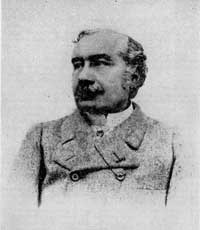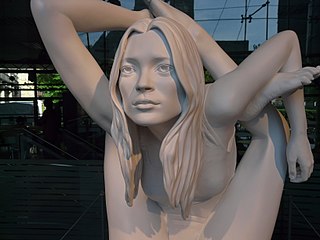A chemical element is a chemical substance that cannot be broken down into other substances. The basic particle that constitutes a chemical element is the atom, and each chemical element is distinguished by the number of protons in the nuclei of its atoms, known as its atomic number. For example, oxygen has an atomic number of 8, meaning that each oxygen atom has 8 protons in its nucleus. This is in contrast to chemical compounds and mixtures, which contain atoms with more than one atomic number.
The discovery of the 118 chemical elements known to exist as of 2023 is presented in chronological order. The elements are listed generally in the order in which each was first defined as the pure element, as the exact date of discovery of most elements cannot be accurately determined. There are plans to synthesize more elements, and it is not known how many elements are possible.

The periodic table, also known as the periodic table of the elements, arranges the chemical elements into rows ("periods") and columns ("groups"). It is an organizing icon of chemistry and is widely used in physics and other sciences. It is a depiction of the periodic law, which says that when the elements are arranged in order of their atomic numbers an approximate recurrence of their properties is evident. The table is divided into four roughly rectangular areas called blocks. Elements in the same group tend to show similar chemical characteristics.

A nonmetal is a chemical element that, in the broadest sense of the term, has a relatively low density and high electronegativity; they range from colorless gases to shiny solids. They are usually poor conductors of heat and electricity, and brittle or crumbly when solid due to their electrons having low mobility. In contrast, metals are good conductors and most are easily flattened into sheets and drawn into wires since their electrons are generally free-moving. Nonmetal atoms tend to attract electrons in chemical reactions and to form acidic compounds.

The boron group are the chemical elements in group 13 of the periodic table, consisting of boron (B), aluminium (Al), gallium (Ga), indium (In), thallium (Tl) and nihonium (Nh). This group lies in the p-block of the periodic table. The elements in the boron group are characterized by having three valence electrons. These elements have also been referred to as the triels.

Paul-Émile Lecoq de Boisbaudran, also called François Lecoq de Boisbaudran, was a French chemist known for his discoveries of the chemical elements gallium, samarium and dysprosium. He developed methods for separation and purification of the rare earth elements and was one of the pioneers of the science of spectroscopy.
A period 4 element is one of the chemical elements in the fourth row of the periodic table of the chemical elements. The periodic table is laid out in rows to illustrate recurring (periodic) trends in the chemical behaviour of the elements as their atomic number increases: a new row is begun when chemical behaviour begins to repeat, meaning that elements with similar behaviour fall into the same vertical columns. The fourth period contains 18 elements beginning with potassium and ending with krypton – one element for each of the eighteen groups. It sees the first appearance of d-block in the table.

The periodic table is an arrangement of the chemical elements, structured by their atomic number, electron configuration and recurring chemical properties. In the basic form, elements are presented in order of increasing atomic number, in the reading sequence. Then, rows and columns are created by starting new rows and inserting blank cells, so that rows (periods) and columns (groups) show elements with recurring properties. For example, all elements in group (column) 18 are noble gases that are largely—though not completely—unreactive.

Lars Fredrik Nilson was a Swedish chemist, professor at Uppsala University, and later Director of the Agricultural Chemical Experiment Station at the Royal Swedish Academy of Agriculture and Forestry in Stockholm.

Andrew Zbigniew Szydlo is a British chemist and chemistry teacher, best known for his talks and lectures on chemistry.

In 2006, Sphinx, a sculpture of the British fashion model Kate Moss in a complicated yoga position was unveiled by the British sculptor Marc Quinn. The life-size sculpture is made of cast bronze, with a white-painted finish, and shows Moss wearing a leotard with her feet and hands behind her head.

The Periodic Table is a 1975 short story collection by Primo Levi, named after the periodic table in chemistry. In 2006, the Royal Institution of Great Britain named it the best science book ever.
Hugh Aldersey-Williams is a British author and journalist. Aldersey-Williams was educated at Highgate School and studied the natural sciences at the University of Cambridge. His several books discuss issues surrounding natural and man-made designs. He has curated exhibitions at the Victoria and Albert Museum as well as the Wellcome Collection.
This is a list of 194 sources that list elements classified as metalloids. The sources are listed in chronological order. Lists of metalloids differ since there is no rigorous widely accepted definition of metalloid. Individual lists share common ground, with variations occurring at the margins. The elements most often regarded as metalloids are boron, silicon, germanium, arsenic, antimony and tellurium. Other sources may subtract from this list, add a varying number of other elements, or both.
The origin and usage of the term metalloid is convoluted. Its origin lies in attempts, dating from antiquity, to describe metals and to distinguish between typical and less typical forms. It was first applied to metals that floated on water, and then more popularly to nonmetals. Only recently, since the mid-20th century, has it been widely used to refer to elements with intermediate or borderline properties between metals and nonmetals.

Eric R. Scerri is a chemist, writer and philosopher of science of Maltese origin. He is a lecturer at the University of California, Los Angeles; and the founder and editor-in-chief of Foundations of Chemistry, an international peer reviewed journal covering the history and philosophy of chemistry, and chemical education.
Chemical elements may be named from various sources: sometimes based on the person who discovered it, or the place it was discovered. Some have Latin or Greek roots deriving from something related to the element, for example some use to which it may have been put.

Sam Kean is an American writer. He has written for The New York Times Magazine, Mental Floss, Slate, Psychology Today, and The New Scientist. He has also published six books which discuss scientific discoveries in a narrative style. His books received positive reviews in The Wall Street JournalLibrary Journal, and The New York Times. He was born in Sioux Falls, South Dakota, and lives in Washington, D.C.

The Disappearing Spoon: And Other True Tales of Madness, Love, and the History of the World from the Periodic Table of the Elements, is a 2010 book by science reporter Sam Kean. The book was first published in hardback on July 12, 2010 through Little, Brown and Company and was released in paperback on June 6, 2011 through Little, Brown and Company's imprint Back Bay Books.












